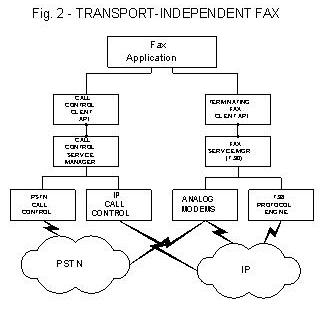Commetrex has developed an architecture for high-density telephony that smoothes the transition from TDM to IP transports for applications such as IVR, unified messaging, audio conferencing, and especially fax. Commetrex’ Open Telecommunications Framework (OTF) takes advantage of the MSP Media Gateway PCI cards configured as “fax boards” to offer analog and digital interfaces to the PSTN. But it goes further by leveraging the economies made possible by blade servers combined with the OTF Kernel telephony middleware to extend the OEM’s coverage to IP networks on the same system platform. This architecture gives the telephony system developer unprecedented options in networks and media that support new high-value applications such as IP-based fax servers.
The enterprise and carrier-equipment vendors must be able to cost-effectively develop applications where the underlying platform renders the network—IP or PSTN—or the transport—G.711 pass-through, T.38 fax relay, or traditional fax modems—transparent to the application. Developers of enterprise systems must be able to take advantage of the power of today’s host processors, which double in power every 18 months while the MIPS required to process a fax media stream have remained relatively constant, and, in the case of T.38, have actually gone down. In today’s market, business as usual with traditional “fax boards” just doesn’t fill the bill.
But why is Commetrex the company to come forward with a new architecture for the industry? It’s the natural result of Commetrex’ position as a leading developer and licensor of fax technologies and framework software, and the Company’s unmatched record of innovation in fax and related technologies.
- In 1994 Commetrex shipped MultiFax, the industry’s first fax software-add-in product. It turned the NMS voice boards into voice-fax boards, and later became the basis of NMS’s NaturalFax. Today, AudioCodes, BICOM, NMS, and Pika, in addition to countless telecom equipment manufacturers (TEMs), base their fax products on Commetrex technology.
- In 1997 Commetrex founded the MSP Consortium to bring the benefits of open architectures to the media-technology level of digital-media telephony. In 1998 the M.100 Media Streams Processing environment specification was published; Commetrex shipped OpenMedia, its M.100 implementation, in 2000.
- In 2000 Commetrex shipped T.38 Fax Relay Software and I.366.2 as licensed technology.
- In 2001 shipped TerminatingT38, the industry’s first and only product to support sending and receiving T.38 real-time IP fax transactions, just as multi-line “fax boards” send and receive PSTN faxes.
- In 2002 opened the hugely successful T.38 Interoperability Lab, significantly improving the interoperability of T.38 products from a dozen TEMs.
- In 2003 shipped Multi-Modal Terminating Fax (MMTF), which allows media servers to send and receive IP faxes whether they are sent through T.38-capable gateways or those that only support G.711 pass-through fax.
- In 2004 shipped BladeWare, the industry’s only SIP-based host-media-processing framework for telecom equipment manufacturers.
- In 2004 shipped the MSP series MSP-H8 of open-architecture PCI telephony boards.
Now, Commetrex is rolling up this portfolio of innovative technologies and products into a new architecture, Open Telecommunications Framework (OTF), which allows the industry’s OEMs and system developers to support, easily and cost-effectively, both PSTN and IP voice and fax applications on the same platform.

The OTF architecture Open Telecommunications Framework® Portal, shown in Figure 1, is comprised of OTF Kernel, which includes client APIs to access system, call, and media services, and the system services, such as authentication, media storage, and call routing. Call control commands are passed on to resource service managers; media services are passed on to media resource controllers. As OTF Kernel is completely open, OEMs can replace or extend any of these services.



 To accomplish this, the application determines the cost of the available routes for a fax to reach its destination. It then executes OTF Kernel commands that will cause the fax to be routed either directly to the PSTN or to the MSP-based gateway in another enterprise location. This is possible because the OTF system has the media technologies needed to support PSTN fax with multi-line fax modems (the MSP Media Gateways serving as fax boards), T.38 IP real-time faxes, and G.711 pass-through faxes.
To accomplish this, the application determines the cost of the available routes for a fax to reach its destination. It then executes OTF Kernel commands that will cause the fax to be routed either directly to the PSTN or to the MSP-based gateway in another enterprise location. This is possible because the OTF system has the media technologies needed to support PSTN fax with multi-line fax modems (the MSP Media Gateways serving as fax boards), T.38 IP real-time faxes, and G.711 pass-through faxes. Both of these boards are sold without software. Then, you only need to license the number of ports required by your application. In the case of the MSP-H8, each port also requires a field-pluggable trunk interface as well as an incremental software runtime license. The board, as shown above, supports one-to-8 lines. The MSP-320 configured with its Quad E1/T1 Daughterboard, supports one-to-120 fax ports over four T or E spans.
Both of these boards are sold without software. Then, you only need to license the number of ports required by your application. In the case of the MSP-H8, each port also requires a field-pluggable trunk interface as well as an incremental software runtime license. The board, as shown above, supports one-to-8 lines. The MSP-320 configured with its Quad E1/T1 Daughterboard, supports one-to-120 fax ports over four T or E spans.





